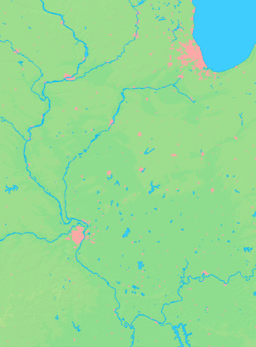Dalton City, Illinois
| Dalton City | |
| Village | |
| Country | United States |
|---|---|
| State | Illinois |
| County | Moultrie |
| Elevation | 686 ft (209 m) |
| Coordinates | 39°42′49″N 88°48′20″W / 39.71361°N 88.80556°WCoordinates: 39°42′49″N 88°48′20″W / 39.71361°N 88.80556°W |
| Area | 0.61 sq mi (2 km2) |
| - land | 0.61 sq mi (2 km2) |
| - water | 0.00 sq mi (0 km2) |
| Density | 941.7/sq mi (364/km2) |
| Timezone | CST (UTC-6) |
| - summer (DST) | CDT (UTC-5) |
| Postal code | 61925 |
| Area code | 217 |
  Location of Dalton City within Illinois
| |
| Wikimedia Commons: Dalton City, Illinois | |
Dalton City is a village in Moultrie County, Illinois, United States. It is in the center of the state near the Macon County line, located along Route 121 at its intersection with Route 128 and between the larger villages of Bethany and Mount Zion. The population was 581 at the 2000 census, nearly 200 more than were present there during the 1960 census.[1]
Dalton City was incorporated as a village on September 15, 1877.[1] The village was the birthplace of Henry Gleason, a 20th-century ecologist and taxonomist.
Since the Cutback amendment Dalton City has been part of the 101st district of the Illinois House of Representatives.[2] As of 2006 it is represented by Democrat Bob Flider of Mount Zion.
Geography
Dalton City is located at 39°42′49″N 88°48′20″W / 39.71361°N 88.80556°W (39.713487, -88.805596),[3] in the West Okaw River watershed.
According to the 2010 census, Dalton City has a total area of 0.613 square miles (1.59 km2), of which 0.61 square miles (1.58 km2) (or 99.51%) is land and 0.003 square miles (0.01 km2) (or 0.49%) is water.[4]
Demographics
| Historical population | |||
|---|---|---|---|
| Census | Pop. | %± | |
| 1880 | 280 | — | |
| 1890 | 334 | 19.3% | |
| 1900 | 388 | 16.2% | |
| 1910 | 400 | 3.1% | |
| 1920 | 446 | 11.5% | |
| 1930 | 403 | −9.6% | |
| 1940 | 354 | −12.2% | |
| 1950 | 384 | 8.5% | |
| 1960 | 386 | 0.5% | |
| 1970 | 427 | 10.6% | |
| 1980 | 574 | 34.4% | |
| 1990 | 573 | −0.2% | |
| 2000 | 581 | 1.4% | |
| 2010 | 544 | −6.4% | |
| Est. 2015 | 527 | [5] | −3.1% |
As of the census[7] of 2000, there were 581 people, 212 households, and 170 families residing in the village. The population density was 941.7 people per square mile (361.8/km²). There were 224 housing units at an average density of 363.1 per square mile (139.5/km²). The racial makeup of the village was 98.62% White, 0.52% African American, 0.52% Native American, 0.17% from other races, and 0.17% from two or more races. Hispanic or Latino of any race were 1.55% of the population.
There were 212 households out of which 44.3% had children under the age of 18 living with them, 69.8% were married couples living together, 6.6% had a female householder with no husband present, and 19.8% were non-families. 17.5% of all households were made up of individuals and 3.8% had someone living alone who was 65 years of age or older. The average household size was 2.74 and the average family size was 3.09.
In the village the population was spread out with 31.2% under the age of 18, 7.2% from 18 to 24, 32.5% from 25 to 44, 21.2% from 45 to 64, and 7.9% who were 65 years of age or older. The median age was 33 years. For every 100 females there were 93.7 males. For every 100 females age 18 and over, there were 97.0 males.
The median income for a household in the village was $48,958, and the median income for a family was $53,224. Males had a median income of $36,094 versus $20,417 for females. The per capita income for the village was $16,946. About 2.8% of families and 4.1% of the population were below the poverty line, including 4.8% of those under age 18 and 10.0% of those age 65 or over.
References
- 1 2 Dalton City from a privately maintained website
- ↑ Map of 101st District, from Rep. Bob Flider's campaign website
- ↑ "US Gazetteer files: 2010, 2000, and 1990". United States Census Bureau. 2011-02-12. Retrieved 2011-04-23.
- ↑ "G001 - Geographic Identifiers - 2010 Census Summary File 1". United States Census Bureau. Retrieved 2015-08-02.
- ↑ "Annual Estimates of the Resident Population for Incorporated Places: April 1, 2010 to July 1, 2015". Retrieved July 2, 2016.
- ↑ "Census of Population and Housing". Census.gov. Archived from the original on May 11, 2015. Retrieved June 4, 2015.
- ↑ "American FactFinder". United States Census Bureau. Archived from the original on September 11, 2013. Retrieved 2008-01-31.
External links
- Dalton City Quadrangle from the Illinois State Geological Survey, a UIUC website